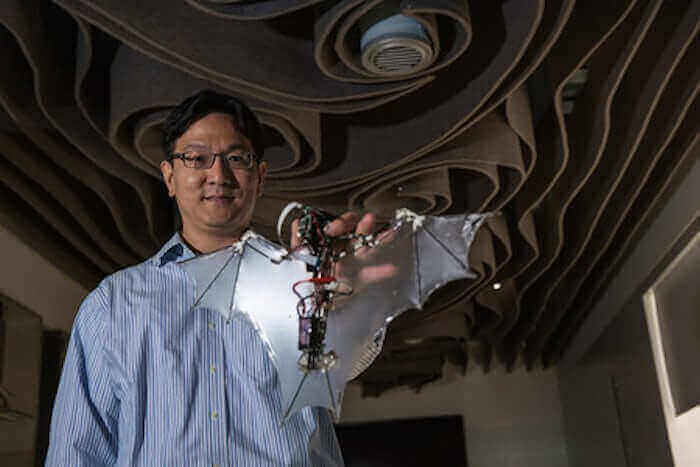Engineers have designed a flying Bat Bot, a robot drone with 3D printed joints that can swoop and dive just like the real thing.
Drones, quad-copters and gliders are dime a dozen nowadays, buzzing through the skies and laden with pizzas or packages from Amazon.
But engineers are still gnawing away on perhaps the greatest challenge of aerial robotics; to replicate the complex flight mechanics of the humble bat. They are a holy grail in the field because of their incomparable agility in the air.
The wait may soon be over. A team of scientists from Caltech and the University of Illinois at Urbana-Champaign have built a robot drone with 3D printed joints that is the closest yet to mimicking bat flight.
Alireza Ramezani, one of the researchers on the project, says:
“Our work demonstrates one of the most advanced designs to date of a self-contained flapping-winged aerial robot with bat morphology that is able to perform autonomous flight.”
And of course, they went and gifted it with the magical moniker of “Bat Bot”. See it in action in the video below:
Bat Bot Would be Great for Land Survey Tasks
The robot bat has a one-foot wingspan and weighs only 93 grams. Its flight mechanism replicates the complex movements of bat wings; it can dive and bank just like its gimlet-eyed cousins. But the difference from nature is that, where the real thing has 40 joints, Bat Bot only requires nine.
Each of the joints are made with 3D printing, with five motors for individual control. The frame of the bot is built from carbon fiber, while the membrane of the wing is a custom silicone material. Incredibly, this material is only 56 microns thick, and stretches and snaps to catch pockets of air that provide thrust.
The bot steers using an onboard computer, but there’s a limit on flight time because of battery and weight constraints. That means the Bat Bot prototype is not yet ready for real-world applications. But more than an impressive feat of engineering, it could prove very useful in the future.
“This robot design will help us build safer and more efficient flying robots, and also give us more insight into the way bats fly,” says Soon-Jo Chung, associate professor of aerospace and Bren Scholar in the Division of Engineering and Applied Science at Caltech, and Jet Propulsion Laboratory research scientist.
A more robust model could perform the same surveying tasks currently undertaken by small drones. For example, reconnoitering a building site or a disaster area. The benefit here is that the bat wing mechanism offers greater power efficiency and more flexibility for maneuvering.
Plus, the Bat Bot design would be much safer than a modern drone or quadcopter. Given the choice between objects falling out of the sky, would you rather be hit on the head by a spinning rotor or gossamer thin membrane? That’s what we thought.
Source: Caltech

License: The text of "Bat Bot is a 3D Printed Robot Drone that Flies like a Bat" by All3DP is licensed under a Creative Commons Attribution 4.0 International License.